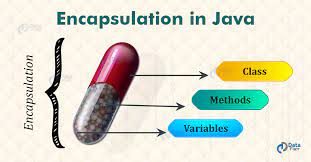Encapsulation refers to the bundling of data with the methods that operate on that data, or the restricting of direct access to some of an object’s components. Encapsulation is used to hide the values or state of a structured data object inside a class, preventing direct access to them by clients in a way that could expose hidden implementation details or violate state invariance maintained by the methods.
Publicly accessible methods are generally provided in the class to access or modify the state more abstractly. In practice sometimes methods (so-called “getters” and “setters”) are provided to access the values indirectly, but, although not necessarily a violation of abstract encapsulation, they are often considered a sign-post of potentially poor object-oriented programming (OOP) design practice (an Anti-pattern).
This mechanism is not unique to OOP. Implementations of abstract data types, e.g., modules, offer a similar form of encapsulation. The similarity has explained by programming language theorists in terms of existential types.
What is the data encapsulation?
Data encapsulation, also known as data hiding, is the mechanism whereby the implementation details of a class are kept hidden from the user. The user can only perform a restricted set of operations on the hidden members of the class by executing special functions commonly called methods.
How can encapsulation be achieved?
Using access specifiers we can achieve encapsulation. Using this we can in turn implement data abstraction. It’s not necessary that we only use private access.
What are the benefits of using encapsulation?
It protects an object from unwanted access by clients. This allows access to a level without revealing the complex details below that level. It reduces human errors. Simplifies the maintenance of the application.
How Encapsulation works as a design principle?
This helps to create code that is loosely couple. Because the details are to hide, it reduces the ability of other objects to directly modify an object’s state and behavior. Not only must you change the data type in the object, but also every time you referenced the object’s time in the entire program!
What are the drawbacks of using encapsulation?
The main disadvantage in Java is it increases the length of the code and slows shutdown execution.
Do objects allow encapsulation?
Every object oriented programming offers this as a feature. It is one of the four fundamental OOP concepts. The other three are inheritance, polymorphism, and abstraction. It provides a layer which allows the classes to be privately accessible to the fields via public methods.
Which statements are benefits?
- Allows a class implementation to change without changing t he clients.
- Protects confidential data from leaking out of the objects.
- Prevents code from causing exceptions.
- Enables the class implementation to protect its invariants.
- Permits classes to combined into the same package.
How does encapsulation increase reliability?
Reliability increases when their design is maximum. As reliability is an attribute of quality, and has a close relation with object oriented design constructs. On the basis of forgoing discussion a hypothesis can propose: As this increases, complexity decreases.
Does encapsulation decrease usability?
In this section we expand on this to discuss the other benefits of this. By keeping data private and providing public well-defined service methods the role of the object becomes clear to other objects. This increases usability. This is essentially a contract between the two objects.
How is object encapsulation useful?
It restricts the free flow of data from one object to another. The data and functions are wrappe together in an object in such a way that the data of a particular object can only be used in associated functions. Thus, it helps in protecting the data from unauthorised access.





